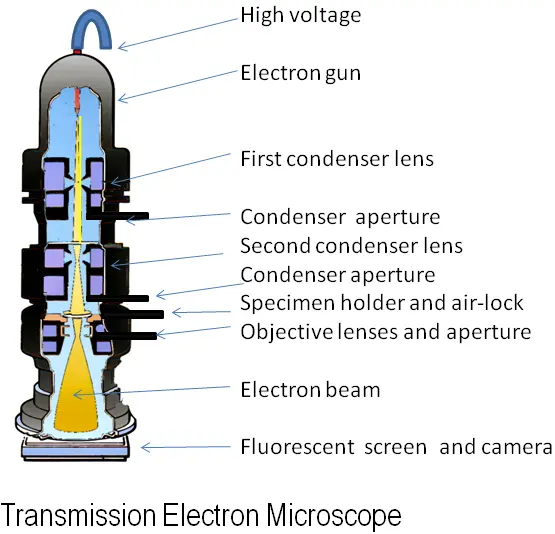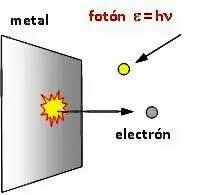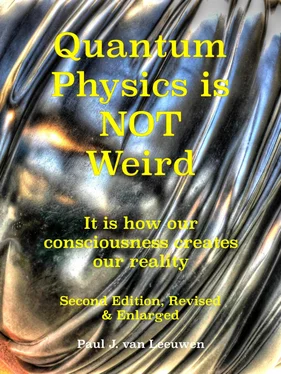The birth of the electron microscope
The discovery of the wave behavior of electrons in 1931 resulted – within 4 years after Davisson's publication in Nature – in the construction of the first electron microscope by Ernst Ruska [ 26 ](1906-1988), together with the German electrical engineer Max Knoll(1897-1969) .
When using a normal light microscope, the size of the tiniest details that are distinguishable is limited by the wavelength of visible light. Details smaller than the wavelengths of this light cannot be distinguished. The light waves do not reflect but just bend around these small objects like waves bend around a buoy at sea. Moving to the use of shorter wavelengths – UV light – is not a viable option since glass does not transmit UV light very well. But, when you are using electrons, you can control their wavelength through their energy. When you give them enough energy to make their wavelength small enough, you can render much smaller details ‘visible’. The prepared microscopic specimen must be able to withstand the electron bombardment as well as the vacuum needed for the electrons to move unhindered. Focusing, as with glass lenses for visible light, can be done for electrons beams with magnetic coils because of the electron charge. See figure 4.14.

Figure 4.14: Electron Microscope.
Source: Wikimedia Commons. Author: Graham Beards
The electron microscope is the first technical instrumental application of quantum physics.
5: Uncertainty, the quantum collapse
“"Consciousness cannot be accounted for in physical terms. For consciousness is absolutely fundamental. It cannot be accounted for in terms of anything else."
Erwin Schrödinger, quantum physicist 1871-1961
At around 1920 quantum physics was still a haphazard collection of intelligent ad hoc hypotheses without a solid mathematically constructed framework. Compared to the elegancy and robustness of Newtonian physics this was – and is still – highly unsatisfactory and even unpalatable for a lot of physicists. The exact predictability of nature proved to be a mirage; uncertainty of measurement turned out to be a fundamental aspect of nature.
Young’s double-slit experiment, that had convincingly demonstrated light’s wave character, and Planck’s quantum of EM-energy, would become the unquestionable testimony of the seemingly incompatible dual nature of the fundamental elements of physical reality as we thought we knew them. Solid looking matter was found to exhibit wave behavior.
The quantum wave that was at first thought to be a spatially spread-out physical particle, was soon acknowledged as a non-material possibility wave. The why and how of the abrupt change of the quantum wave into the measured physical particle, turned out to become the hottest debated subject between quantum physicists. A plethora of interpretations – some even connecting the consciousness of the observer with the observed quantum phenomena – proliferated.
Double-slit with single electrons or photons
The Bohr atom model gained a firmer foothold with the Davisson-Germer experiment, but the idea that particles also had a wave character caused many physicists to experience strong feelings of disbelief and unease. Therefore, many experiments had to be done to confirm this paradoxical behavior. Electrons and photons are very apt for such experiments because they are easy to bundle and fire, but also larger objects such as protons and even large molecules [1]are confirmed to show demonstrable wave behavior. Many of those experiments are sophisticated versions of the double-slit experiment.

Figure 5.1: Confusing message: electrons pictured as simultaneous traveling particles and waves.
There is a tremendous amount of confusing information to be found on the paradoxical particle-wave behavior of quantum objects. You will encounter this in popular science literature, on the Internet in countless YouTube videos, and in the better academic media. The above figure 5.1 concerning the Davisson-Germer experiment, found at www.natuurkunde.nl, may serve here as an example. In both situations, upper left and right, electrons are depicted as concrete particles traveling a path, however ultimately bringing interference about. That’s simply confusing and – as we shall see – even misleading.
With such confusing representations – which have their origin in a stubborn material Newtonian image of the world – you are already misled before you even start to delve deeper into quantum physics. We will see that there is much to be said about these material-physical duality representations and that they are not necessary either.
Not only with electrons – repeatedly pictured as tiny matter balls – but also with photons, we encounter often this confusing dual image of particles that are simultaneously acting as matter and wave. Figure 5.2 intended as a clarifying illustration of the photoelectric effect, can be found on Wikimedia Commons. The figure shows a photon traveling in the form of an energy particle – a Newton corpuscle – on its way to the metal surface to release there an electron particle. It is important to realize that this kind of behavior has been never observed by instruments. This is an image intended to aid comprehension; however, the effect is confusion.

Figure 5.2: Misleading and confusing: both photon and electron presented as speeding tiny hard balls.
Source: Wikimedia Commons.
My advice is this. Try to keep, albeit it can be sometimes helpful, the idea of little particles physically traveling along a concrete path – and therefore existing at every point of their path at every point in time – at bay, set it apart from your ideas about reality. If you succeed in such a mental stance, it won’t be mind-shattering when it becomes apparent that this image cannot be correct.
However, the particle image of a quantum object can serve as a helpful mental crutch, an approach that I will often use when analyzing experiments on the following pages. It can be useful, but keep in mind that the image of a persistent material object is not necessarily a presentation of reality. The contradictions that we encounter when we try to maintain the image of persistent particles will demonstrate that the particle image must be wrong. Most mathematicians consider a proof by contradiction [ 2 ]as valid.
In any case, it should be clear now that, whether we fire photons or electrons at a double-slit, we will observe an interference pattern on the screen behind the slits. This outcome has been confirmed in numerous experiments in many laboratories. An interference pattern showing up in an experiment is considered by every physicist as evidence that the electrons and photons used in their experiments behaved like waves. However, please keep in mind again that this inference is not bulletproof in a strictly logical sense. In logic it is not allowed to derive from proposition A => B (wave thus interference) the proposition B => A (interference so the electron is a wave).
What the actual ‘substance’ is that is behaving like a wave has not been determined. In other words, the photon and the electron exhibitwave behavior but do not have to be these waves themselves, just like the surfer is not the wave. It is unquestionably true that waves do play an important role when we observe interference. I am not disputing that. But this illogical inference has serious consequences for any attempt to understand the implications of quantum physics, it confuses the issue as we will see.
Читать дальше















